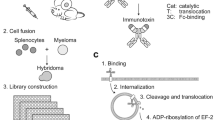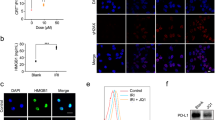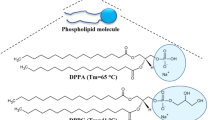Summary
We have investigated the antiproliferative action towards CC531 colon adenocarcinoma cells of target cell-specific immunoliposomes containing the amphiphilic dipalmitoyl derivative of 5-fluorodeoxyuridine (FUdR-dP). FUdR-dP incorporated in immunoliposomes caused a 13-fold stronger inhibition of CC531 cell growth in vitro, during a 72-h treatment, than FUdR-dP in liposomes without antibody, demonstrating that the prodrug is efficiently hydrolysed to yield the active drug, FUdR, intracellularly. The intracellular release of active FUdR was confirmed by determining the fate of 3H-labelled immunoliposomal FUdR-dP. Treatments shorter than 72 h with FUdR-dP in immunoliposomes resulted in anti-tumour activities comparable to, or even higher than, that of free FUdR. The shorter treatments reflect more closely the in vivo situation and illustrate the potential advantage of the use of immunoliposomes over non-targeted liposomal FUdR-dP or free FUdR. Association of tumour cell-specific immunoliposomes with CC531 cells was up to tenfold higher than that of liposomes without antibody or with irrelevant IgG coupled, demonstrating a specific interaction between liposomes and target cells which causes an efficient intracellular delivery of the drug. Since biochemical evidence indicates a lack of internalization or degradation of the liposomes as such, we postulate that entry of the drug most likely involves the direct transfer of the prodrug from the immunoliposome to the cell membrane during its antigen-specific interaction with the cells, followed by hydrolysis of FUdR-dP leading to relatively high intracellular FUdR-levels. In conclusion, we describe a targeted liposomal formulation for the anticancer drug FUdR, which is able to deliver the active drug to colon carcinoma cells with high efficiency, without the need for the cells to internalize the liposomes as such.
Similar content being viewed by others
Article PDF
Change history
16 November 2011
This paper was modified 12 months after initial publication to switch to Creative Commons licence terms, as noted at publication
References
Ahmad, I., Longenecker, M., Samuel, J. & Allen, T. M. (1993). Antibody-targeted delivery of doxorubicin entrapped in sterically stabilized liposomes can eradicate lung cancer in mice. Cancer Res 53: 1484–1488.
Allen, T. M. (1997). Liposomes: opportunities in drug delivery. Drugs 54: 8–14.
Allen, T. M. & Chonn, A. (1987). Large unilamellar liposomes with low uptake into the reticuloendothelial system. FEBS Lett 223: 42–46.
Allen, T. M., Hansen, C., Martin, F., Redemann, C. & Yau Young, A. (1991). Liposomes containing synthetic lipid derivatives of poly(ethylene glycol) show prolonged circulation half-lives in vivo. Biochim Biophys Acta 1066: 29–36.
Beun, G. D., van Eendenburg, D. H., Corver, W. E., van de Velde, C. J. & Fleuren, G. J. (1992). T-cell retargeting using bispecific monoclonal antibodies in a rat colon carcinoma model. I. Significant bispecific lysis of syngeneic colon carcinoma CC531 is critically dependent on prolonged preactivation of effector T-lymphocytes by immobilized anti-T-cell receptor antibody. J Immunother 11: 238–248.
Beun, G. D., Gorter, A., Nooyen, Y., van de Velde, C. J. & Fleuren, G. J. (1993). T cell retargeting using bispecific monoclonal antibodies in a rat colon carcinoma model. II. Syngeneic colon carcinoma CC531 is efficiently killed by retargeted cytotoxic T lymphocytes in vitro despite limited lysis in 51Cr release assays. J Immunol 150: 2305–2315.
Böttcher, C. J. F., Van Gent, C. M. & Pries, C. (1961). A rapid and sensitive sub-micro phosphorus determination. Anal Chim Acta 24: 203–204.
Danenberg, P. V. (1977). Thymidylate synthetase – a target enzyme in cancer chemotherapy. Biochim Biophys Acta 473: 73–92.
Derksen, J. T. P., Morselt, H. W. M. & Scherphof, G. L. (1988). Uptake and processing of immunoglobulin-coated liposomes by subpopulations of rat liver macrophages. Biochim Biophys Acta 971: 127–136.
Derksen, J. T. P. & Scherphof, G. L. (1985). An improved method for the covalent coupling of proteins to liposomes. Biochim Biophys Acta 814: 151–155.
Dingemans, K. P., van den Bergh Weerman, M. A., Keep, R. F. & Das, P. K. (1994). Developmental stages in experimental liver metastases: relation to invasiveness. Int J Cancer 57: 433–439.
Ensminger, W. D., Rosowsky, A., Raso, V., Levin, D. C., Glode, M., Come, S., Steele, G. & Frei, E. (1978). A clinical-pharmacological evaluation of hepatic arterial infusions of 5-fluoro-2′-deoxyuridine and 5-fluorouracil. Cancer Res 38: 3784–3792.
Gregoriadis, G. (1995). Engineering liposomes for drug delivery: progress and problems. Trends Biotechnol 13: 527–537.
Hoekstra, D., Tomasini, R. & Scherphof, G. L. (1980). Interactions of phospholipid vesicles with rat hepatocytes in vitro. Influence of vesicle-incorporated glycolipids. Biochim Biophys Acta 603: 336–346.
Kamps, JAAM, Swart, P. J., Morselt, H. W. M., Pauwels, R., De Bethune, M. P., De Clercq, E., Meijer, D. K. F. & Scherphof, G. L. (1996). Preparation and characterization of conjugates of (modified) human serum albumin and liposomes: drug carriers with an intrinsic anti-HIV activity. Biochim Biophys Acta 1278: 183–190.
Kemeny, N. E. (1995). Regional chemotherapy of colorectal cancer. Eur J Cancer 31A: 1271–1276.
Kemeny, N. (1996). Colorectal cancer – An undertreated disease. Anti-Cancer Drugs 7: 1–7.
Kinsky, S. C. & Loader, J. E. (1987). Circumvention of the methotrexate transport system by methotrexate-phosphatidylethanolamine derivatives: effect of fatty acid chain length. Biochim Biophys Acta 921: 96–103.
Liu, D., Song, Y. K. & Liu, F. (1995). Antibody dependent, complement mediated liver uptake of liposomes containing GM1 . Pharm Res 12: 1775–1780.
Lowry, O. H., Rosebrough, N. J., Farr, A. L. & Randall, R. J. (1951). Protein measurement with the folin phenol reagent. J Biol Chem 193: 265–275.
Marinelli, A., Dijkstra, F. R., van Dierendonck, J. H., Kuppen, P. J., Cornelisse, C. J. & van de Velde, C. J. (1991). Effectiveness of isolated liver perfusion with mitomycin C in the treatment of liver tumours of rat colorectal cancer. Br J Cancer 64: 74–78.
Marquet, R. L., Westbroek, D. L. & Jeekel, J. (1984). Interferon treatment of a transplantable rat colon adenocarcinoma: importance of tumor site. Int J Cancer 33: 689–692.
Martin, F. J. & Papahadjopoulos, D. (1982). Irreversible coupling of immunoglobulin fragments to preformed vesicles. An improved method for liposome targeting. J Biol Chem 257: 286–288.
Maruyama, K., Kennel, S. J. & Huang, L. (1990). Lipid composition is important for highly efficient target binding and retention of immunoliposomes. Proc Natl Acad Sci USA 87: 5744–5748.
Mayer, L. D., Tai, L. C., Ko, D. S., Masin, D., Ginsberg, R. S., Cullis, P. R. & Bally, M. B. (1989). Influence of vesicle size, lipid composition, and drug-to-lipid ratio on the biological activity of liposomal doxorubicin in mice. Cancer Res 49: 5922–5930.
Meropol, N. J., Creaven, P. J. & Petrelli, N. J. (1995). Metastatic colorectal cancer: advances in biochemical modulation and new drug development. Semin Oncol 22: 509–524.
Mori, A., Kennel, S. J., Van Borssum Waalkes, M., Scherphof, G. L. & Huang, L. (1995). Characterization of organ-specific immunoliposomes for delivery of 3′,5′-O-dipalmitoyl-5-fluoro-2′-deoxyuridine in a mouse lung-metastasis model. Cancer Chemother Pharmacol 35: 447–456.
Myers, C. E. (1981). The pharmacology of the fluoropyrimidines. Pharmacol Rev 33: 1–15.
Nishizawa, Y. & Casida, J. E. (1965). 3′,5′-diesters of 5-fluoro-2′-deoxyuridine: synthesis and biological activity. Biochem Pharmacol 14: 1605–1619.
Papahadjopoulos, D., Allen, T. M., Gabizon, A., Mayhew, E., Matthay, K., Huang, S. K., Lee, K. D., Woodle, M. C., Lasic, D. D., Redemann, C. & Martin, F. J. (1991). Sterically stabilized liposomes: improvements in pharmacokinetics and antitumor therapeutic efficacy. Proc Natl Acad Sci USA 88: 11460–11464.
Petterson, G. L. (1977). A simplification of the protein assay method of Lowry et al. which is more generally applicable. Anal Biochem 83: 346–356.
Scherphof, G. L. (1991). In vivo behaviour of liposomes: Interactions with the mononuclear phagocyte system and implications for drug targeting. In Handbook of Experimental Pharmacology, Juliano RL (ed), pp. 285–327. Springer Verlag: Berlin
Scherphof, G. L., Maruyama, K., Van Borssum Waalkes, M., Hoekstra, D., Damen, J., Kennel, S. J. & Huang, L. (1992). Lipid flow phenomena between liposomes, lipoproteins and cell membranes: applications in drug delivery. In Liposome Dermatics, Braun-Falco O, Korting HC and Maibach HI (eds), pp. 11–19. Springer Verlag: Berlin
Scherphof, G. L., Kamps, JAAM & Koning, G. A. (1997). In vivo targeting of surface-modified liposomes to metastatically growing colon carcinoma cells and sinusoidal endothelial cells in the rat liver. J Liposome Res 7: 419–432.
Schwendener, R. A., Supersaxo, A., Rubas, W., Weder, H. G., Hartmann, H. R., Schott, H., Ziegler, A. & Hengartner, H. (1985). 5′-O-Palmitoyl- and 3′,5′-O-dipalmitoyl-5-fluoro-2′-deoxyuridine – novel lipophilic analogues of 5′-fluoro-2′-deoxyuridine: synthesis, incorporation into liposomes and preliminary biological results. Biochem Biophys Res Commun 126: 660–666.
Storm, G. & Crommelin, D. J. A. (1997). Colloidal systems for tumor targeting. Hybridoma 16: 119–125.
Supersaxo, A., Rubas, W., Hartmann, H. R., Schott, H., Hengartner, H. & Schwendener, R. A. (1988). The antitumour effect of lipophilic derivatives of 5-fluoro-2′-deoxyuridine incorporated into liposomes. J Microencapsul 5: 1–11.
Thomas, C., Nijenhuis, A. M., Timens, W., Kuppen, P. J., Daemen, T. & Scherphof, G. L. (1993). Liver metastasis model of colon cancer in the rat: immunohistochemical characterization. Invasion Metast 13: 102–112.
Vaage, J., Donovan, D., Uster, P. & Working, P. (1997). Tumour uptake of doxorubicin in polyethylene glycol-coated liposomes and therapeutic effect against a xenografted human pancreatic carcinoma. Br J Cancer 75: 482–486.
Vahrmeijer, A. L., van Dierendonck, J. H. & van de Velde, C. J. (1995). Treatment of colorectal cancer metastases confined to the liver. Eur J Cancer 31A: 1238–1242.
Van Borssum Waalkes, M. & Scherphof, G. L. (1990). Liposome-incorporated 3′,5′-O-dipalmitoyl-5-fluoro-2′-deoxyuridine as a slow-release antitumor drug depot in rat liver macrophages. Selective Cancer Ther 6: 15–22.
Van Borssum Waalkes, M., Fichtner, I., Dontje, B., Lemm, M., Becker, M., Arndt, D. & Scherphof, G. L. (1992). In vivo distribution and antitumour activity of liposomal 3′,5′-O-dipalmitoyl-5-fluoro-2′-deoxyuridine. J Microencapsul 9: 335–346.
Van Borssum Waalkes, M., Van Galen, M., Morselt, H. W. M., Sternberg, B. & Scherphof, G. L. (1993). In-vitro stability and cytostatic activity of liposomal formulations of 5-fluoro-2′-deoxyuridine and its diacylated derivatives. Biochim Biophys Acta 1148: 161–172.
Author information
Authors and Affiliations
Rights and permissions
From twelve months after its original publication, this work is licensed under the Creative Commons Attribution-NonCommercial-Share Alike 3.0 Unported License. To view a copy of this license, visit http://creativecommons.org/licenses/by-nc-sa/3.0/
About this article
Cite this article
Koning, G., Gorter, A., Scherphof, G. et al. Antiproliferative effect of immunoliposomes containing 5-fluorodeoxyuridine-dipalmitate on colon cancer cells. Br J Cancer 80, 1718–1725 (1999). https://doi.org/10.1038/sj.bjc.6690588
Received:
Revised:
Accepted:
Published:
Issue date:
DOI: https://doi.org/10.1038/sj.bjc.6690588
Keywords
This article is cited by
-
Improving Intracellular Doxorubicin Delivery Through Nanoliposomes Equipped with Selective Tumor Cell Membrane Permeabilizing Short-Chain Sphingolipids
Pharmaceutical Research (2013)
-
A New Class of 5-Fluoro-2?-deoxyuridine Prodrugs Conjugated with a Tumor-Homing Cyclic Peptide CNGRC by Ester Linkers: Synthesis, Reactivity, and Tumor-Cell?Selective Cytotoxicity
Pharmaceutical Research (2005)



